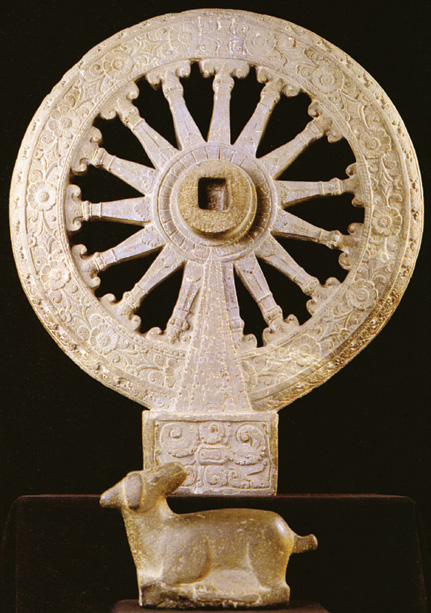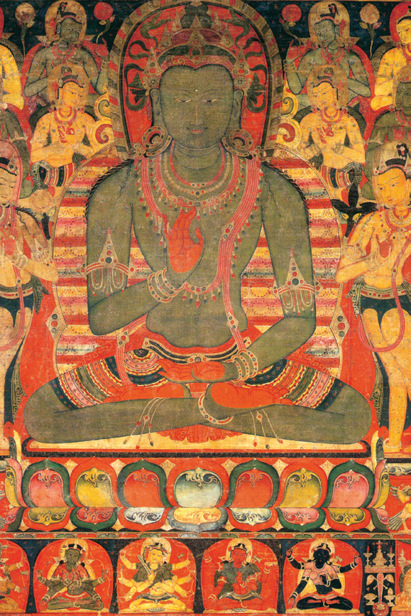An Illustrated Outline of Buddhism: The Essentials of Buddhist Spirituality (13 page)
Read An Illustrated Outline of Buddhism: The Essentials of Buddhist Spirituality Online
Authors: William Stoddart,Joseph A. Fitzgerald
Tags: #Philosophy

one of the titles of the Buddha is
Shūnyamūrti
,
“Manifestation of the
Void”. This title is a clear indication of the Buddha’s role as
Logos
or
Avatārā.
In Buddhism, Ultimate Reality is also referred to, in different
contexts, as
Dharma
(“Law”),
Bodhi
(“Awakening”, “Enlightenment”,
“Knowledge”), and
Ātmā
(“Self”).
Ultimate or Divine Reality—and
this is particularly the case in
Mahāyāna
Buddhism—is also regarded
as a Supreme Being.1
1 Relevant here, and applicable in all religions, is the theological distinction between
God Transcendent, the Divine Being or “Object” (
Brahma
,
Mahāvairochana
,
Jehovah
,
Allāh
)
and God Immanent, the Divine Self or “Subject” (
Ātmā
).

32
An Illustrated Outline of Buddhism
The foregoing makes it clear why, whether Ultimate Reality be
primarily viewed as a Supreme State (
Nirvāna
)
or a Supreme Being
(
Dharmakāya
or
Mahāvairochana
),
it is erroneous to call Buddhism
“atheistic”. Ultimate Reality, as envisaged by Buddhism (be it conceived
as “State” or “Being”), is absolute, infinite, and perfect, and these are
precisely the transcendent categories that atheism denies.
Likewise, it is incorrect to call Buddhism a “philosophy” (in the
modern sense of this word), rather than a “religion”. Apart from the
fact that common sense tel s us that Buddhism has all the marks of a
religion, and not a “philosophy”, Buddhism is a religion for the simple
reason that, unlike post-Renaissance “philosophies”, it is not man-
made, but has its origin in a divine revelation.
*
* *
On receiving “enlightenment” (
bodhi
)—which amounted to the provi-
dential revelation of Buddhism—, Siddhārtha Gautama himself be-
came the
Buddha
(the “Enlightened One”). He also enjoys other ti-
tles, such as,
Shākyamuni
(“Sage of the Shākya tribe”),
Shūnyamūrti
(“Manifestation of the Void” or “Exteriorization of the Inward”), and
Tathāgata
(the “Thus-Gone” or the “Ful y-Arrived”, i.e., the one who
has himself accomplished, and now “incarnates” both the path and
the Goal). The Buddha is also identified with
Mahākarunā
,
the “Great
Compassion”.
The Buddha’s life story, as outlined in the preceding pages, provides
the framework for the central doctrine of the Buddhist religion, which
the Buddha himself expressed in the following words: “I teach two
things only, O disciples, suffering and release from suffering.” His life
story likewise provides the background for his doctrine of the “Middle
Way” (Sanskrit:
madhyamā-pratipad
/Pali:
maj hima-pātipadā
),
that is
to say, the golden mean between asceticism and self-indulgence.
All the Buddha’s essential teachings were given in his famous First
Sermon, “the First Setting in Motion of the Wheel of the Law” (
Dhar-
machakra Pravatana
),
and are enshrined in what are known as “The
Four Noble Truths” and “The Eightfold Path”.



The Nature and the Teachings of Buddhism
33
Stone Wheel of the Law (
Dharmachakra
), Thailand, 7th-8th century







